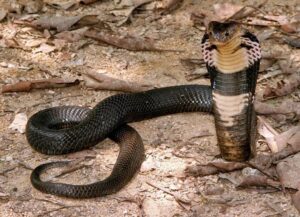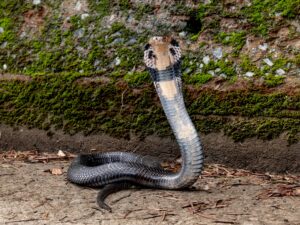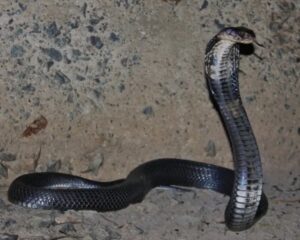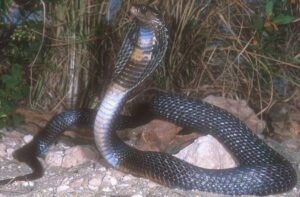
The Chinese cobra, also known as the Chinese spectacled snake, the long-chinned snake, and the Taiwan cobra, is the most prominent venomous cobra in China and Taiwan, which has caused the most number of snakebite fatalities in these countries.
Naja is a Latinisation of the Sanskrit word “naga,” meaning “Cobra,” and atra comes from the Latin word “ater,” meaning “black,” “dark,” or “gloomy.” They were first described in 1842 by Danish zoologist, botanist, and physician Theodore Edward Cantor. These medium-sized snakes belong to the Elapidae family.
These snakes are terrestrial, crepuscular, and diurnal. Because of their alertness, they are rarely cornered. The Chinese cobras can be very aggressive if threatened. They can spread their hood, raise their forebody and strike readily if necessary. Despite killing many people due to snakebites, their numbers are declining due to habitat degradation, pollution, and intensive hunting.
Scientific Classifications
- Suborder:Serpentes
- Family:Elapidae
- Genus:Naja
- Species:N. atra
Conservation Status
Description
Size
The average length of these snakes is 46.8–58.8 inches (120–150 cm), with a maximum of 79.2 inches (200 cm) which rarely occurs.
Color and Appearance
Chinese cobras have black, brown, or grey-colored backs with light yellow stomachs. It has faint vertical banding from the body’s midsection to the tail. A white or light grey ring on its neck transforms into a monocle-like pattern when the cobra displays its hood.
The Chinese cobras are found throughout Taiwan, and their ventral color varies based on which part of Taiwan they are found. The ones from the eastern population are 100% blackish, the ones living in central and southern parts of the country are 80% white and gray, and the northern population is 30-60% blackish and white-gray.
They have broad heads that are slightly triangular and distinct from the neck. These cobras have heavy and somewhat flattened bodies. Their dorsal scales are shiny and even, whereas the dorsolateral scales are highly oblique. They have large and prominent nostrils and short tails. Their eyes are medium-sized with jet-black, round pupils. The iris of their eyes is dark, dirty yellow with patches of blue-black or grey-black. Their fangs, situated at the anterior of the upper jaw, are permanently erect.
These cobras have 23-29 rows of scales around the hood and 19-21 rows just ahead mid-body. They also have 161-180 ventral scales (171 in males and 173 in females) and 37-51 pairs of subcaudal scales (48 in males and 46 in females).
Are They Dangerous to Humans
They are venomous snakes with a yield range of 150 to 200 mg (dry weight). With a murine LD50 value of 0.29 mg/kg IV, their venom contains postsynaptic neurotoxins and cardiotoxins. It has four cardiotoxin analogs that account for about 54% of the dry weight of crude venom. They are not spitting cobras but can eject poison toward a person from a distance of 6.6 feet (2 meters).
Symptoms of its bite include darkening of the spot, redness, swelling, insensibility, pain, necrosis, and blisters. Other severe symptoms are breathing difficulty, chest discomfort, sore throat, fever, weakening of limbs, loss of voice, difficulty walking, and lockjaw. Death happens occasionally. Fatal conditions can be prevented if antivenom is given on time.
The younger specimens are more aggressive than adults because they are more nervous. Usually, these snakes avoid confrontation with humans. But if highly provoked, they can strike and inject venom through their short, fixed fangs near the front of the upper jaw. Today, the fatalities caused by these cobras are less due to the availability of antivenom worldwide.
Chinese Cobra at a Glance
Distribution
Chinese cobras are found in Southeastern China (including Fujian, Hunan, Hubei, Guangxi, Guangdong, Guizhou, Sichuan, and Zhejiang), Taiwan, Hong Kong, northern Vietnam, and northern Laos.

Habitat
These snakes live primarily in grasslands, woodlands, scrublands, and mangroves. They are adaptable to various terrains such as open fields, jungles, grassland plains, and heavily populated areas. They prefer avoiding dark forests with a closed canopy. They can reside up to an elevation of more than 2000 meters above sea level. They are also found in rice fields near river banks, ponds, and lakes, where they like to hide in the daytime.

Lifespan
The average lifespan of Chinese cobras is 10 to 12 years.
Diet
These cobras are carnivores and eat a varied range of species. Their primary diet consists of rodents, toads, fish, frogs, and other snakes. Juveniles feed on amphibians, whereas adults prefer reptiles and mammals. Adult cobras live mostly on frogs or toads, such as the Asian common toad, the common tree frog, and the cricket frog, during the amphibian breeding period.
Reproduction
Chinese cobras are egg-laying species. Their breeding season is from March through May. The females can lay 6 to 23 eggs between May and July and guard them for two months until the young ones are born. The time between mating and egg-laying is very long. The newborns are 30 cm long and can hunt and fend for themselves right after birth.
Similar Species
Indian Cobra
Indian cobras are found in the Indian subcontinent. They are also venomous and medium-sized snakes like Chinese cobras.
King Cobra
King and Chinese cobra are relatives because they belong to the Elapidae family. However, king cobras are 2 – 3 times longer than Chinese cobras.
Egyptian Cobra
These venomous snakes are found in North Africa. They are one of Africa’s largest cobras, belonging to the genus Naja.
Rat Snakes
Rat snakes possess similar scales to the cobras, but unlike cobras, they are non-venomous.
Monocled Cobra
This snake is often mistaken for the Chinese cobra. But unlike monocled cobras, the Chinese cobras have lower ventral and subcaudal scale counts.
Source
world.fandom.com, animalia.bio, researchgate.net, squarespace-cdn.com, i.pinimg.com







